Strategic Planning and Performance Metrics: A Premium Inn Analysis
VerifiedAdded on 2023/06/15
|10
|3270
|380
Report
AI Summary
This report provides a comprehensive analysis of strategic planning within the hospitality industry, using Premium Inn as a case study. It explores factors influencing strategy implementation, such as perceived service level, customer satisfaction, marketplace dynamics, demographic factors, and change management. The report also delves into creative business strategies for enhancing competitiveness, including hyper-local content creation, clear contact information, structured data mark-up, and display advertising. Furthermore, it examines various performance metrics like critical success factors, emotional maturity, optimization, agile processes, and user involvement. The analysis aims to provide insights into how Premium Inn can optimize its strategies for sustainable growth, improved customer loyalty, and enhanced profitability. Desklib is your go-to resource for similar solved assignments and study tools.
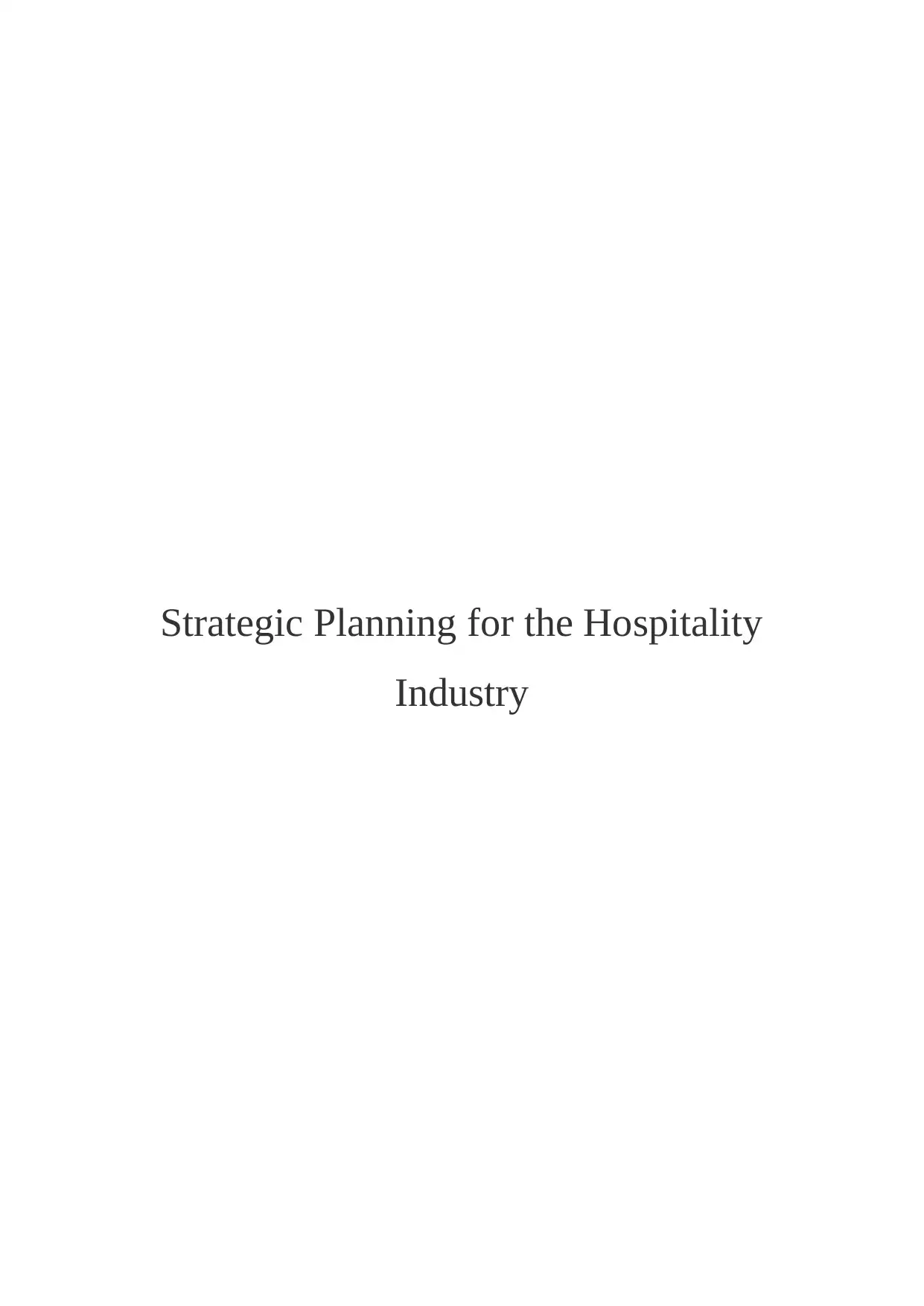
Strategic Planning for the Hospitality
Industry
Industry
Paraphrase This Document
Need a fresh take? Get an instant paraphrase of this document with our AI Paraphraser

Table of Contents
INTRODUCTION.................................................................................................................... 3
1. Appropriate factors to implement a strategy......................................................................3
2. Creative business strategies for organisation’s future strategy selection to be competitive in the
hospitality industry................................................................................................................ 5
3. Different performance metrics.........................................................................................7
CONCLUSION........................................................................................................................ 9
REFERENCES:...................................................................................................................... 10
INTRODUCTION.................................................................................................................... 3
1. Appropriate factors to implement a strategy......................................................................3
2. Creative business strategies for organisation’s future strategy selection to be competitive in the
hospitality industry................................................................................................................ 5
3. Different performance metrics.........................................................................................7
CONCLUSION........................................................................................................................ 9
REFERENCES:...................................................................................................................... 10

INTRODUCTION
Strategic planning refers to the procedure through which the organization leaders decides
their visions and mission for the future to set the appropriate goals for organization. The
process involves establishment of sequences according to which the goals set will be attained
to ultimately reach its vision. Hospitality industry is the broader umbrella which involves
various sectors within it such as food and drink sector, travel, accommodations sectors and
entertainment sector etc. (Konovalova and et.al., 2018). Premium inn is a British service
chain which is the largest hotel brand of UK. It operates in a variety of locations such as
suburbs, airports and city centres as well. Its headquarters is in United Kingdom, but it have
various subsidiaries in various countries. The report of the aim is to analyse the factors to
implement a strategy, different performance metrics and the research of creative business
strategies for future strategy selection in Premium Inn.
1. Appropriate factors to implement a strategy
Strategy refers to the plan or a course of action which is designed to attain a particular
outcome. Strategy are the action which organization managers or leaders undertake for
attaining the goals and objectives of organization.
There are various business strategies which organizations such as Premium Inn can
undertake. Some key popular strategies can involve group bookings, revenue management
strategy, cross promotional strategy, guest reward strategy and destination marketing etc. For
the current project the chosen strategy is rewarding loyal customers. Premium Inn can
implement this strategy to enhance its customer base as well as to improve its brand name
and brand loyalty. Premium Inn can implement this through adoption of various ways such as
offering discounts to high spend customers who have visited more than twice in last six
months. Another way to implement this strategy is to provide a loyalty card to the customers
who have visited the hotel for more than four-five times (Alharbi, Dowling and Bhatti, 2019).
This way the company can analyse how often the customers visit the hotel. Premium Inn can
offer additional services on discounted rates or for free to its regular customers. It can also
invite the customers for the trial of its new services and products. It make the customers to
feel valued and important for the company. This creates a different kind relationship of
customers with the company which makes them to retain with company for longer term. This
can help in attracting the customers of other companies to shift from them and become a
customer of the chosen company.
Strategic planning refers to the procedure through which the organization leaders decides
their visions and mission for the future to set the appropriate goals for organization. The
process involves establishment of sequences according to which the goals set will be attained
to ultimately reach its vision. Hospitality industry is the broader umbrella which involves
various sectors within it such as food and drink sector, travel, accommodations sectors and
entertainment sector etc. (Konovalova and et.al., 2018). Premium inn is a British service
chain which is the largest hotel brand of UK. It operates in a variety of locations such as
suburbs, airports and city centres as well. Its headquarters is in United Kingdom, but it have
various subsidiaries in various countries. The report of the aim is to analyse the factors to
implement a strategy, different performance metrics and the research of creative business
strategies for future strategy selection in Premium Inn.
1. Appropriate factors to implement a strategy
Strategy refers to the plan or a course of action which is designed to attain a particular
outcome. Strategy are the action which organization managers or leaders undertake for
attaining the goals and objectives of organization.
There are various business strategies which organizations such as Premium Inn can
undertake. Some key popular strategies can involve group bookings, revenue management
strategy, cross promotional strategy, guest reward strategy and destination marketing etc. For
the current project the chosen strategy is rewarding loyal customers. Premium Inn can
implement this strategy to enhance its customer base as well as to improve its brand name
and brand loyalty. Premium Inn can implement this through adoption of various ways such as
offering discounts to high spend customers who have visited more than twice in last six
months. Another way to implement this strategy is to provide a loyalty card to the customers
who have visited the hotel for more than four-five times (Alharbi, Dowling and Bhatti, 2019).
This way the company can analyse how often the customers visit the hotel. Premium Inn can
offer additional services on discounted rates or for free to its regular customers. It can also
invite the customers for the trial of its new services and products. It make the customers to
feel valued and important for the company. This creates a different kind relationship of
customers with the company which makes them to retain with company for longer term. This
can help in attracting the customers of other companies to shift from them and become a
customer of the chosen company.
⊘ This is a preview!⊘
Do you want full access?
Subscribe today to unlock all pages.

Trusted by 1+ million students worldwide
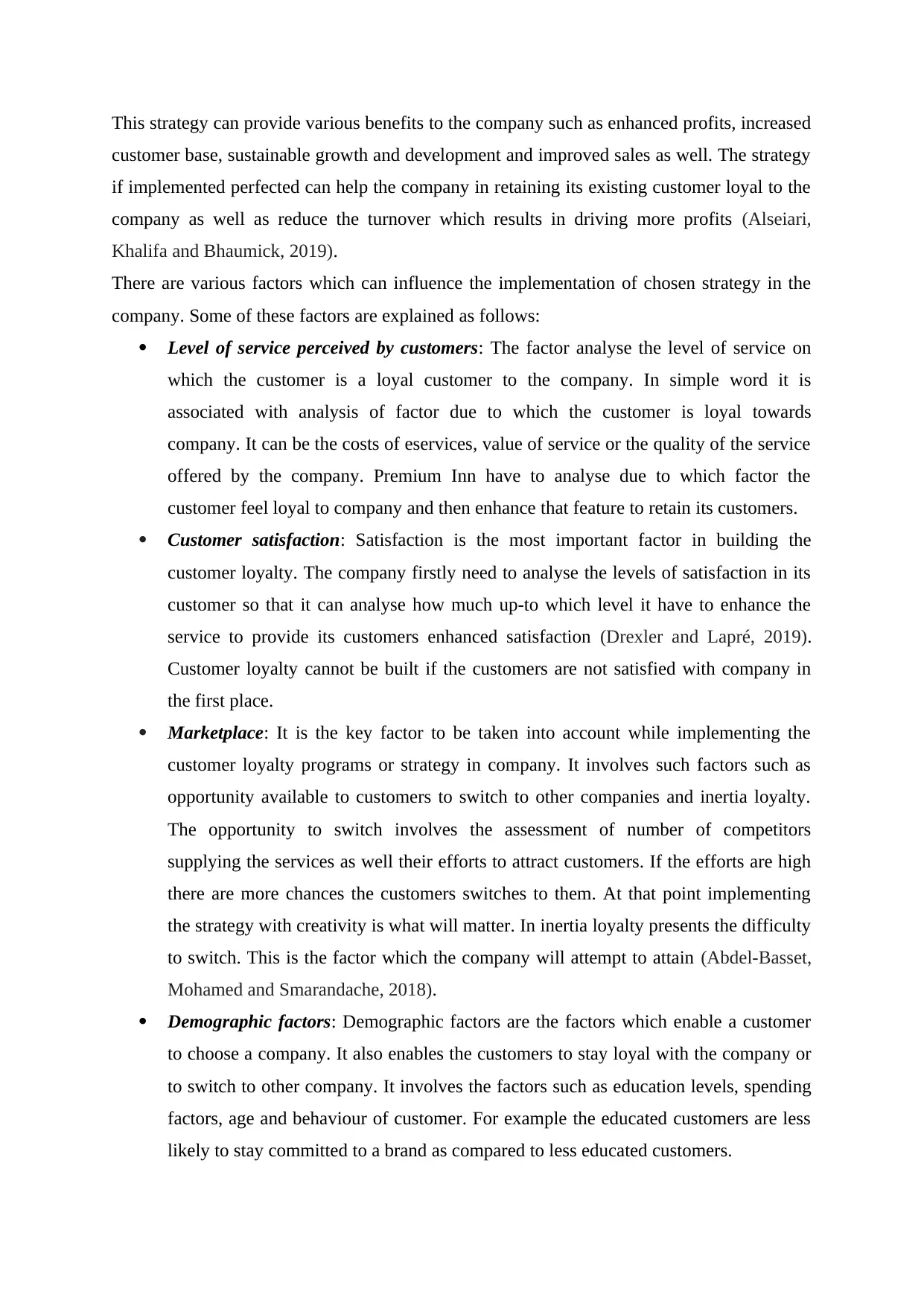
This strategy can provide various benefits to the company such as enhanced profits, increased
customer base, sustainable growth and development and improved sales as well. The strategy
if implemented perfected can help the company in retaining its existing customer loyal to the
company as well as reduce the turnover which results in driving more profits (Alseiari,
Khalifa and Bhaumick, 2019).
There are various factors which can influence the implementation of chosen strategy in the
company. Some of these factors are explained as follows:
Level of service perceived by customers: The factor analyse the level of service on
which the customer is a loyal customer to the company. In simple word it is
associated with analysis of factor due to which the customer is loyal towards
company. It can be the costs of eservices, value of service or the quality of the service
offered by the company. Premium Inn have to analyse due to which factor the
customer feel loyal to company and then enhance that feature to retain its customers.
Customer satisfaction: Satisfaction is the most important factor in building the
customer loyalty. The company firstly need to analyse the levels of satisfaction in its
customer so that it can analyse how much up-to which level it have to enhance the
service to provide its customers enhanced satisfaction (Drexler and Lapré, 2019).
Customer loyalty cannot be built if the customers are not satisfied with company in
the first place.
Marketplace: It is the key factor to be taken into account while implementing the
customer loyalty programs or strategy in company. It involves such factors such as
opportunity available to customers to switch to other companies and inertia loyalty.
The opportunity to switch involves the assessment of number of competitors
supplying the services as well their efforts to attract customers. If the efforts are high
there are more chances the customers switches to them. At that point implementing
the strategy with creativity is what will matter. In inertia loyalty presents the difficulty
to switch. This is the factor which the company will attempt to attain (Abdel-Basset,
Mohamed and Smarandache, 2018).
Demographic factors: Demographic factors are the factors which enable a customer
to choose a company. It also enables the customers to stay loyal with the company or
to switch to other company. It involves the factors such as education levels, spending
factors, age and behaviour of customer. For example the educated customers are less
likely to stay committed to a brand as compared to less educated customers.
customer base, sustainable growth and development and improved sales as well. The strategy
if implemented perfected can help the company in retaining its existing customer loyal to the
company as well as reduce the turnover which results in driving more profits (Alseiari,
Khalifa and Bhaumick, 2019).
There are various factors which can influence the implementation of chosen strategy in the
company. Some of these factors are explained as follows:
Level of service perceived by customers: The factor analyse the level of service on
which the customer is a loyal customer to the company. In simple word it is
associated with analysis of factor due to which the customer is loyal towards
company. It can be the costs of eservices, value of service or the quality of the service
offered by the company. Premium Inn have to analyse due to which factor the
customer feel loyal to company and then enhance that feature to retain its customers.
Customer satisfaction: Satisfaction is the most important factor in building the
customer loyalty. The company firstly need to analyse the levels of satisfaction in its
customer so that it can analyse how much up-to which level it have to enhance the
service to provide its customers enhanced satisfaction (Drexler and Lapré, 2019).
Customer loyalty cannot be built if the customers are not satisfied with company in
the first place.
Marketplace: It is the key factor to be taken into account while implementing the
customer loyalty programs or strategy in company. It involves such factors such as
opportunity available to customers to switch to other companies and inertia loyalty.
The opportunity to switch involves the assessment of number of competitors
supplying the services as well their efforts to attract customers. If the efforts are high
there are more chances the customers switches to them. At that point implementing
the strategy with creativity is what will matter. In inertia loyalty presents the difficulty
to switch. This is the factor which the company will attempt to attain (Abdel-Basset,
Mohamed and Smarandache, 2018).
Demographic factors: Demographic factors are the factors which enable a customer
to choose a company. It also enables the customers to stay loyal with the company or
to switch to other company. It involves the factors such as education levels, spending
factors, age and behaviour of customer. For example the educated customers are less
likely to stay committed to a brand as compared to less educated customers.
Paraphrase This Document
Need a fresh take? Get an instant paraphrase of this document with our AI Paraphraser
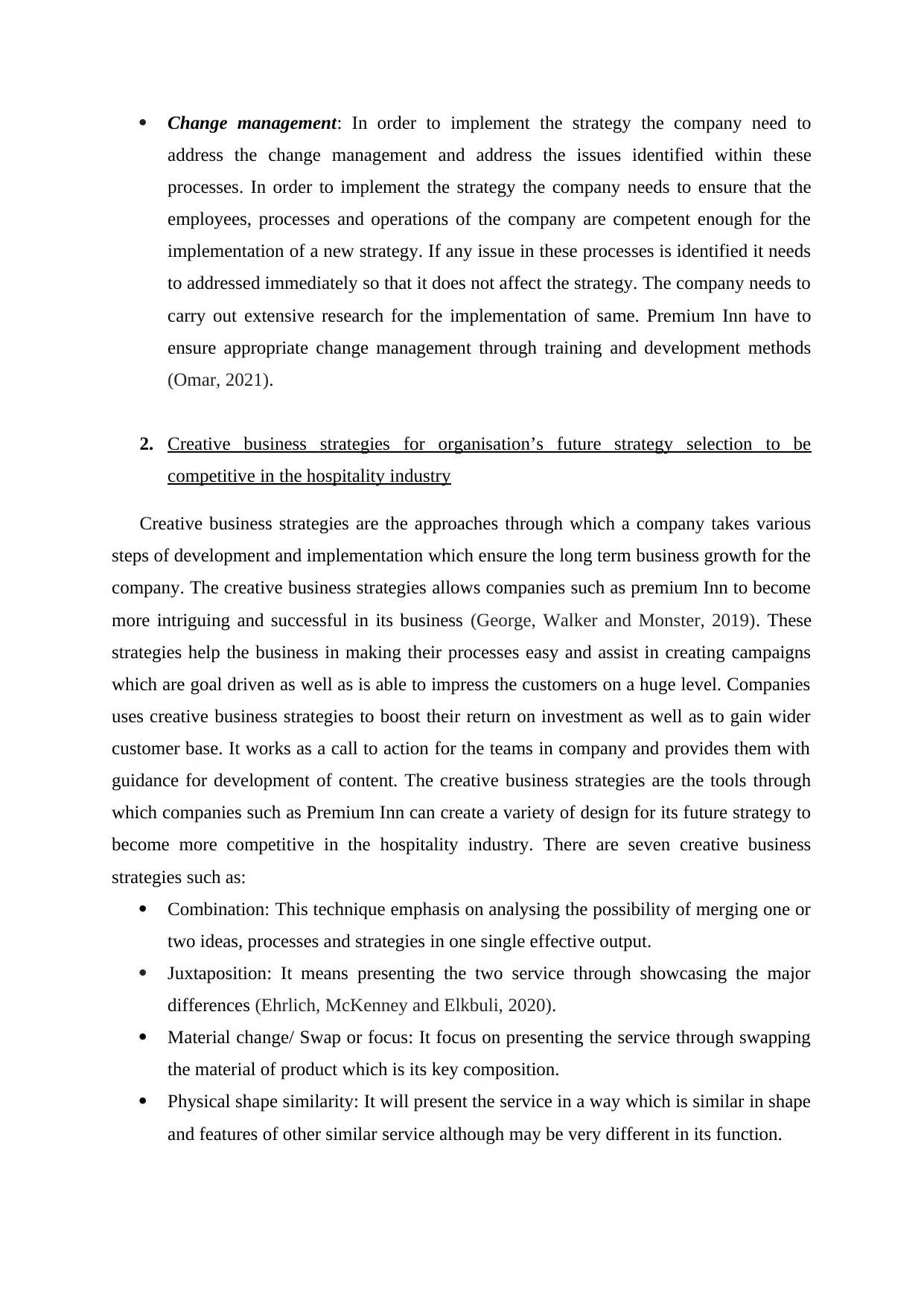
Change management: In order to implement the strategy the company need to
address the change management and address the issues identified within these
processes. In order to implement the strategy the company needs to ensure that the
employees, processes and operations of the company are competent enough for the
implementation of a new strategy. If any issue in these processes is identified it needs
to addressed immediately so that it does not affect the strategy. The company needs to
carry out extensive research for the implementation of same. Premium Inn have to
ensure appropriate change management through training and development methods
(Omar, 2021).
2. Creative business strategies for organisation’s future strategy selection to be
competitive in the hospitality industry
Creative business strategies are the approaches through which a company takes various
steps of development and implementation which ensure the long term business growth for the
company. The creative business strategies allows companies such as premium Inn to become
more intriguing and successful in its business (George, Walker and Monster, 2019). These
strategies help the business in making their processes easy and assist in creating campaigns
which are goal driven as well as is able to impress the customers on a huge level. Companies
uses creative business strategies to boost their return on investment as well as to gain wider
customer base. It works as a call to action for the teams in company and provides them with
guidance for development of content. The creative business strategies are the tools through
which companies such as Premium Inn can create a variety of design for its future strategy to
become more competitive in the hospitality industry. There are seven creative business
strategies such as:
Combination: This technique emphasis on analysing the possibility of merging one or
two ideas, processes and strategies in one single effective output.
Juxtaposition: It means presenting the two service through showcasing the major
differences (Ehrlich, McKenney and Elkbuli, 2020).
Material change/ Swap or focus: It focus on presenting the service through swapping
the material of product which is its key composition.
Physical shape similarity: It will present the service in a way which is similar in shape
and features of other similar service although may be very different in its function.
address the change management and address the issues identified within these
processes. In order to implement the strategy the company needs to ensure that the
employees, processes and operations of the company are competent enough for the
implementation of a new strategy. If any issue in these processes is identified it needs
to addressed immediately so that it does not affect the strategy. The company needs to
carry out extensive research for the implementation of same. Premium Inn have to
ensure appropriate change management through training and development methods
(Omar, 2021).
2. Creative business strategies for organisation’s future strategy selection to be
competitive in the hospitality industry
Creative business strategies are the approaches through which a company takes various
steps of development and implementation which ensure the long term business growth for the
company. The creative business strategies allows companies such as premium Inn to become
more intriguing and successful in its business (George, Walker and Monster, 2019). These
strategies help the business in making their processes easy and assist in creating campaigns
which are goal driven as well as is able to impress the customers on a huge level. Companies
uses creative business strategies to boost their return on investment as well as to gain wider
customer base. It works as a call to action for the teams in company and provides them with
guidance for development of content. The creative business strategies are the tools through
which companies such as Premium Inn can create a variety of design for its future strategy to
become more competitive in the hospitality industry. There are seven creative business
strategies such as:
Combination: This technique emphasis on analysing the possibility of merging one or
two ideas, processes and strategies in one single effective output.
Juxtaposition: It means presenting the two service through showcasing the major
differences (Ehrlich, McKenney and Elkbuli, 2020).
Material change/ Swap or focus: It focus on presenting the service through swapping
the material of product which is its key composition.
Physical shape similarity: It will present the service in a way which is similar in shape
and features of other similar service although may be very different in its function.
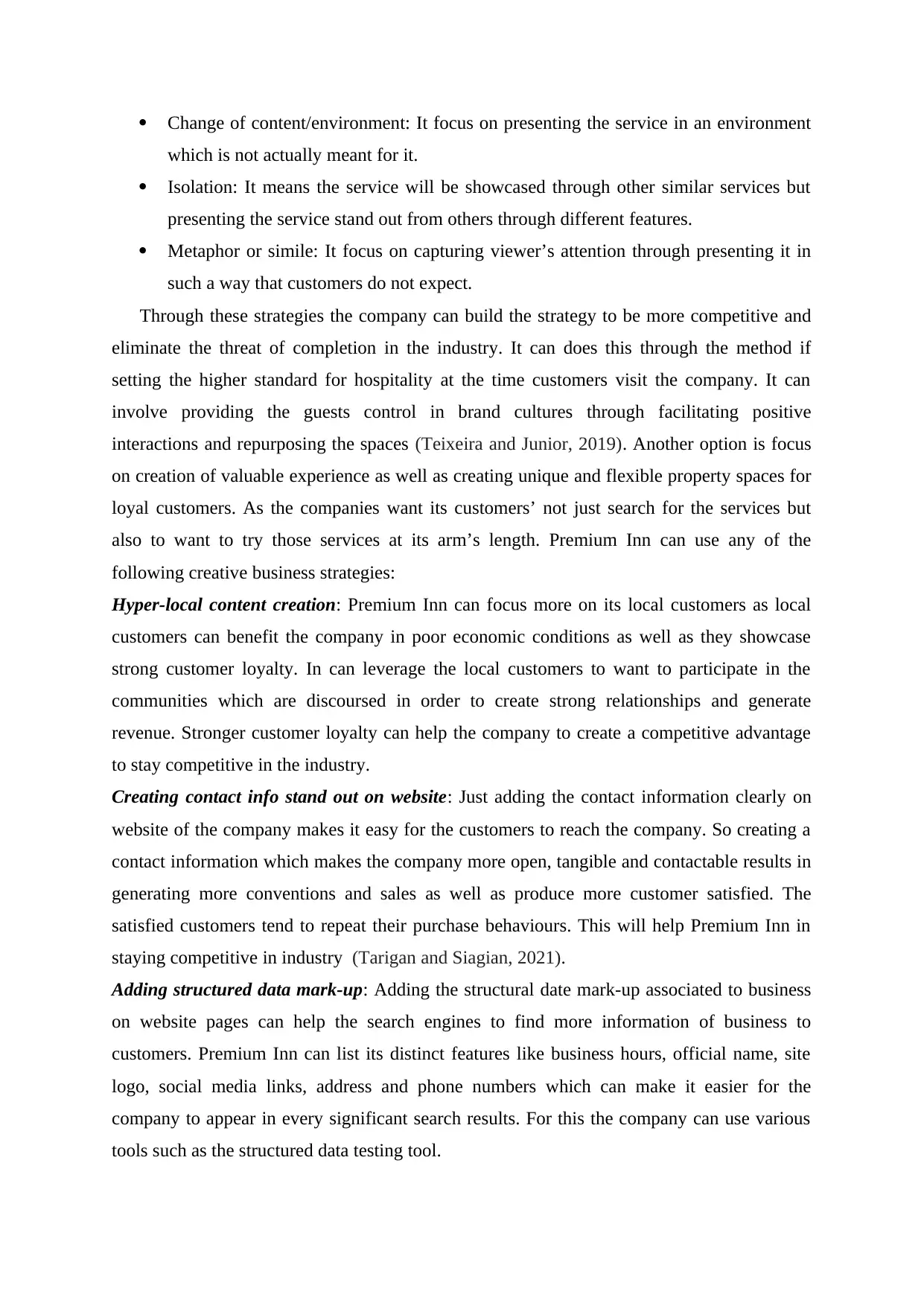
Change of content/environment: It focus on presenting the service in an environment
which is not actually meant for it.
Isolation: It means the service will be showcased through other similar services but
presenting the service stand out from others through different features.
Metaphor or simile: It focus on capturing viewer’s attention through presenting it in
such a way that customers do not expect.
Through these strategies the company can build the strategy to be more competitive and
eliminate the threat of completion in the industry. It can does this through the method if
setting the higher standard for hospitality at the time customers visit the company. It can
involve providing the guests control in brand cultures through facilitating positive
interactions and repurposing the spaces (Teixeira and Junior, 2019). Another option is focus
on creation of valuable experience as well as creating unique and flexible property spaces for
loyal customers. As the companies want its customers’ not just search for the services but
also to want to try those services at its arm’s length. Premium Inn can use any of the
following creative business strategies:
Hyper-local content creation: Premium Inn can focus more on its local customers as local
customers can benefit the company in poor economic conditions as well as they showcase
strong customer loyalty. In can leverage the local customers to want to participate in the
communities which are discoursed in order to create strong relationships and generate
revenue. Stronger customer loyalty can help the company to create a competitive advantage
to stay competitive in the industry.
Creating contact info stand out on website: Just adding the contact information clearly on
website of the company makes it easy for the customers to reach the company. So creating a
contact information which makes the company more open, tangible and contactable results in
generating more conventions and sales as well as produce more customer satisfied. The
satisfied customers tend to repeat their purchase behaviours. This will help Premium Inn in
staying competitive in industry (Tarigan and Siagian, 2021).
Adding structured data mark-up: Adding the structural date mark-up associated to business
on website pages can help the search engines to find more information of business to
customers. Premium Inn can list its distinct features like business hours, official name, site
logo, social media links, address and phone numbers which can make it easier for the
company to appear in every significant search results. For this the company can use various
tools such as the structured data testing tool.
which is not actually meant for it.
Isolation: It means the service will be showcased through other similar services but
presenting the service stand out from others through different features.
Metaphor or simile: It focus on capturing viewer’s attention through presenting it in
such a way that customers do not expect.
Through these strategies the company can build the strategy to be more competitive and
eliminate the threat of completion in the industry. It can does this through the method if
setting the higher standard for hospitality at the time customers visit the company. It can
involve providing the guests control in brand cultures through facilitating positive
interactions and repurposing the spaces (Teixeira and Junior, 2019). Another option is focus
on creation of valuable experience as well as creating unique and flexible property spaces for
loyal customers. As the companies want its customers’ not just search for the services but
also to want to try those services at its arm’s length. Premium Inn can use any of the
following creative business strategies:
Hyper-local content creation: Premium Inn can focus more on its local customers as local
customers can benefit the company in poor economic conditions as well as they showcase
strong customer loyalty. In can leverage the local customers to want to participate in the
communities which are discoursed in order to create strong relationships and generate
revenue. Stronger customer loyalty can help the company to create a competitive advantage
to stay competitive in the industry.
Creating contact info stand out on website: Just adding the contact information clearly on
website of the company makes it easy for the customers to reach the company. So creating a
contact information which makes the company more open, tangible and contactable results in
generating more conventions and sales as well as produce more customer satisfied. The
satisfied customers tend to repeat their purchase behaviours. This will help Premium Inn in
staying competitive in industry (Tarigan and Siagian, 2021).
Adding structured data mark-up: Adding the structural date mark-up associated to business
on website pages can help the search engines to find more information of business to
customers. Premium Inn can list its distinct features like business hours, official name, site
logo, social media links, address and phone numbers which can make it easier for the
company to appear in every significant search results. For this the company can use various
tools such as the structured data testing tool.
⊘ This is a preview!⊘
Do you want full access?
Subscribe today to unlock all pages.

Trusted by 1+ million students worldwide
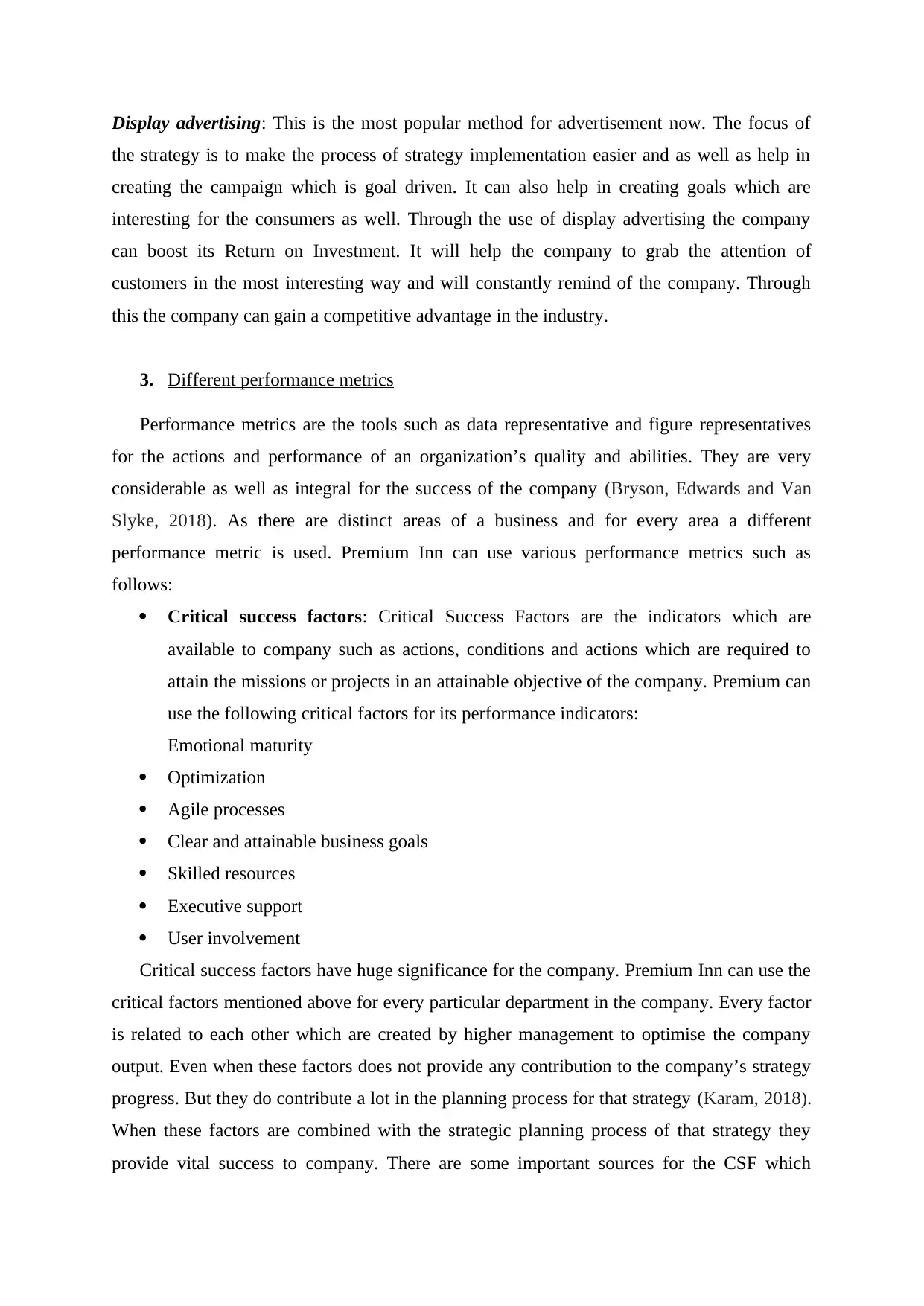
Display advertising: This is the most popular method for advertisement now. The focus of
the strategy is to make the process of strategy implementation easier and as well as help in
creating the campaign which is goal driven. It can also help in creating goals which are
interesting for the consumers as well. Through the use of display advertising the company
can boost its Return on Investment. It will help the company to grab the attention of
customers in the most interesting way and will constantly remind of the company. Through
this the company can gain a competitive advantage in the industry.
3. Different performance metrics
Performance metrics are the tools such as data representative and figure representatives
for the actions and performance of an organization’s quality and abilities. They are very
considerable as well as integral for the success of the company (Bryson, Edwards and Van
Slyke, 2018). As there are distinct areas of a business and for every area a different
performance metric is used. Premium Inn can use various performance metrics such as
follows:
Critical success factors: Critical Success Factors are the indicators which are
available to company such as actions, conditions and actions which are required to
attain the missions or projects in an attainable objective of the company. Premium can
use the following critical factors for its performance indicators:
Emotional maturity
Optimization
Agile processes
Clear and attainable business goals
Skilled resources
Executive support
User involvement
Critical success factors have huge significance for the company. Premium Inn can use the
critical factors mentioned above for every particular department in the company. Every factor
is related to each other which are created by higher management to optimise the company
output. Even when these factors does not provide any contribution to the company’s strategy
progress. But they do contribute a lot in the planning process for that strategy (Karam, 2018).
When these factors are combined with the strategic planning process of that strategy they
provide vital success to company. There are some important sources for the CSF which
the strategy is to make the process of strategy implementation easier and as well as help in
creating the campaign which is goal driven. It can also help in creating goals which are
interesting for the consumers as well. Through the use of display advertising the company
can boost its Return on Investment. It will help the company to grab the attention of
customers in the most interesting way and will constantly remind of the company. Through
this the company can gain a competitive advantage in the industry.
3. Different performance metrics
Performance metrics are the tools such as data representative and figure representatives
for the actions and performance of an organization’s quality and abilities. They are very
considerable as well as integral for the success of the company (Bryson, Edwards and Van
Slyke, 2018). As there are distinct areas of a business and for every area a different
performance metric is used. Premium Inn can use various performance metrics such as
follows:
Critical success factors: Critical Success Factors are the indicators which are
available to company such as actions, conditions and actions which are required to
attain the missions or projects in an attainable objective of the company. Premium can
use the following critical factors for its performance indicators:
Emotional maturity
Optimization
Agile processes
Clear and attainable business goals
Skilled resources
Executive support
User involvement
Critical success factors have huge significance for the company. Premium Inn can use the
critical factors mentioned above for every particular department in the company. Every factor
is related to each other which are created by higher management to optimise the company
output. Even when these factors does not provide any contribution to the company’s strategy
progress. But they do contribute a lot in the planning process for that strategy (Karam, 2018).
When these factors are combined with the strategic planning process of that strategy they
provide vital success to company. There are some important sources for the CSF which
Paraphrase This Document
Need a fresh take? Get an instant paraphrase of this document with our AI Paraphraser
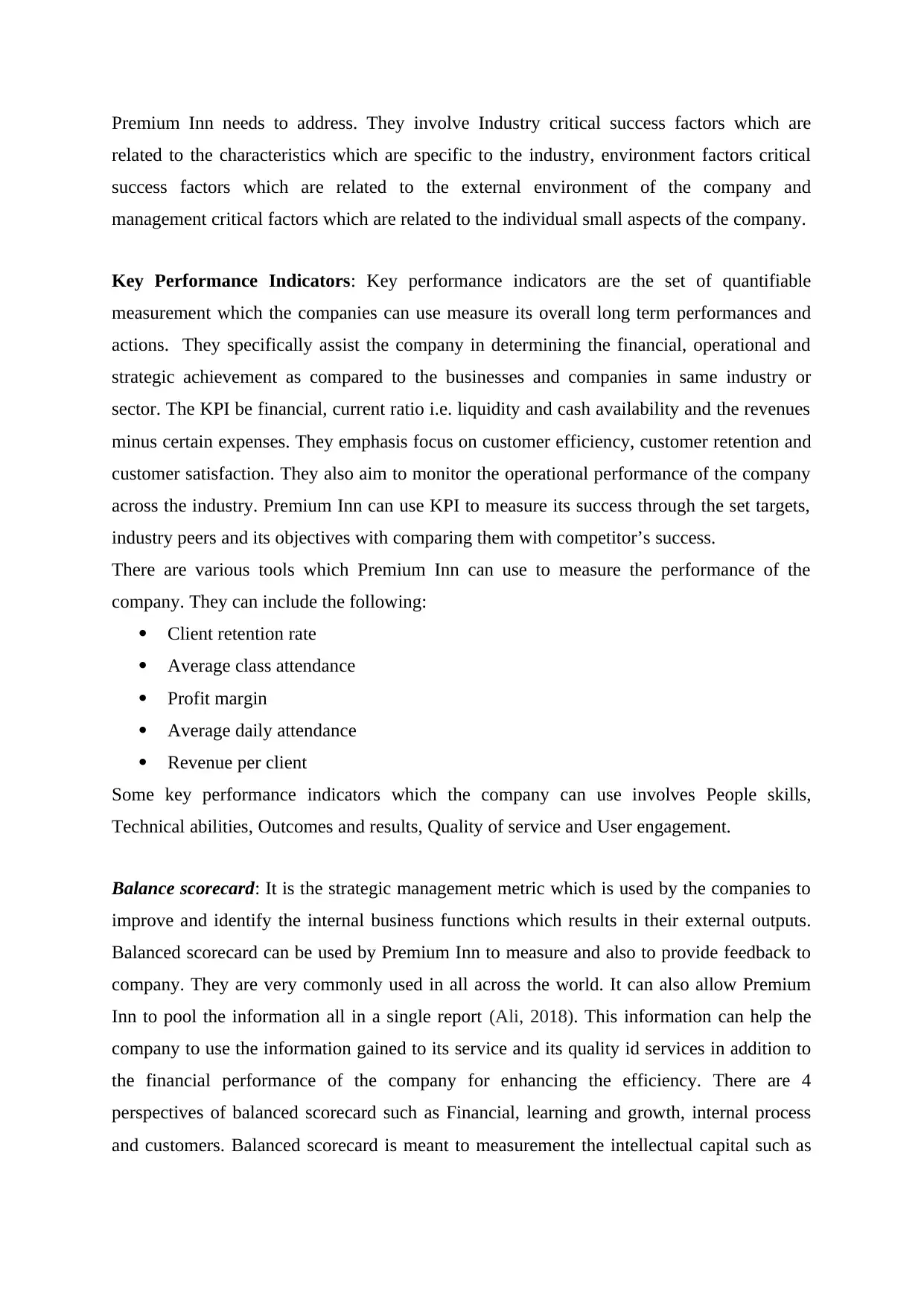
Premium Inn needs to address. They involve Industry critical success factors which are
related to the characteristics which are specific to the industry, environment factors critical
success factors which are related to the external environment of the company and
management critical factors which are related to the individual small aspects of the company.
Key Performance Indicators: Key performance indicators are the set of quantifiable
measurement which the companies can use measure its overall long term performances and
actions. They specifically assist the company in determining the financial, operational and
strategic achievement as compared to the businesses and companies in same industry or
sector. The KPI be financial, current ratio i.e. liquidity and cash availability and the revenues
minus certain expenses. They emphasis focus on customer efficiency, customer retention and
customer satisfaction. They also aim to monitor the operational performance of the company
across the industry. Premium Inn can use KPI to measure its success through the set targets,
industry peers and its objectives with comparing them with competitor’s success.
There are various tools which Premium Inn can use to measure the performance of the
company. They can include the following:
Client retention rate
Average class attendance
Profit margin
Average daily attendance
Revenue per client
Some key performance indicators which the company can use involves People skills,
Technical abilities, Outcomes and results, Quality of service and User engagement.
Balance scorecard: It is the strategic management metric which is used by the companies to
improve and identify the internal business functions which results in their external outputs.
Balanced scorecard can be used by Premium Inn to measure and also to provide feedback to
company. They are very commonly used in all across the world. It can also allow Premium
Inn to pool the information all in a single report (Ali, 2018). This information can help the
company to use the information gained to its service and its quality id services in addition to
the financial performance of the company for enhancing the efficiency. There are 4
perspectives of balanced scorecard such as Financial, learning and growth, internal process
and customers. Balanced scorecard is meant to measurement the intellectual capital such as
related to the characteristics which are specific to the industry, environment factors critical
success factors which are related to the external environment of the company and
management critical factors which are related to the individual small aspects of the company.
Key Performance Indicators: Key performance indicators are the set of quantifiable
measurement which the companies can use measure its overall long term performances and
actions. They specifically assist the company in determining the financial, operational and
strategic achievement as compared to the businesses and companies in same industry or
sector. The KPI be financial, current ratio i.e. liquidity and cash availability and the revenues
minus certain expenses. They emphasis focus on customer efficiency, customer retention and
customer satisfaction. They also aim to monitor the operational performance of the company
across the industry. Premium Inn can use KPI to measure its success through the set targets,
industry peers and its objectives with comparing them with competitor’s success.
There are various tools which Premium Inn can use to measure the performance of the
company. They can include the following:
Client retention rate
Average class attendance
Profit margin
Average daily attendance
Revenue per client
Some key performance indicators which the company can use involves People skills,
Technical abilities, Outcomes and results, Quality of service and User engagement.
Balance scorecard: It is the strategic management metric which is used by the companies to
improve and identify the internal business functions which results in their external outputs.
Balanced scorecard can be used by Premium Inn to measure and also to provide feedback to
company. They are very commonly used in all across the world. It can also allow Premium
Inn to pool the information all in a single report (Ali, 2018). This information can help the
company to use the information gained to its service and its quality id services in addition to
the financial performance of the company for enhancing the efficiency. There are 4
perspectives of balanced scorecard such as Financial, learning and growth, internal process
and customers. Balanced scorecard is meant to measurement the intellectual capital such as
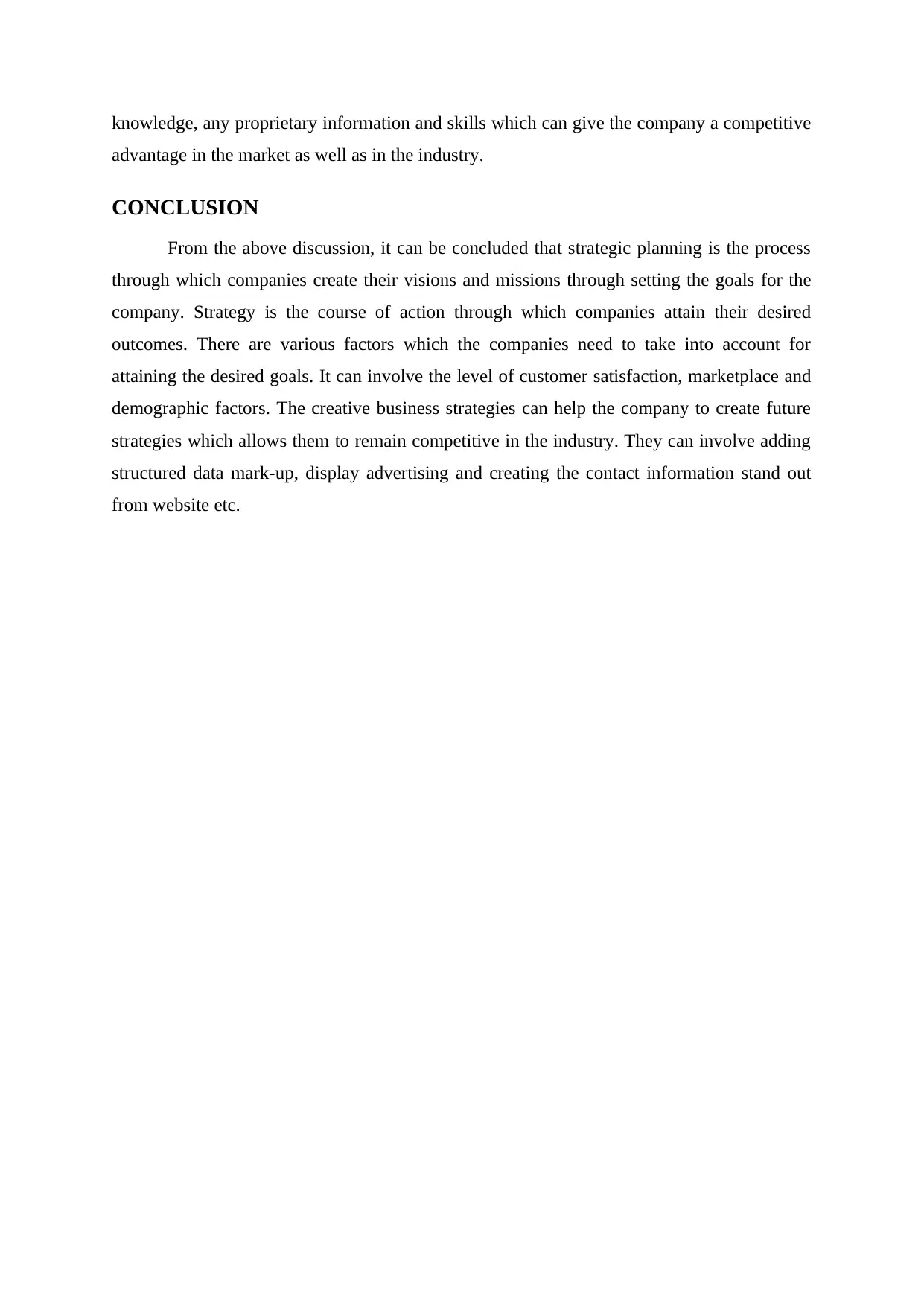
knowledge, any proprietary information and skills which can give the company a competitive
advantage in the market as well as in the industry.
CONCLUSION
From the above discussion, it can be concluded that strategic planning is the process
through which companies create their visions and missions through setting the goals for the
company. Strategy is the course of action through which companies attain their desired
outcomes. There are various factors which the companies need to take into account for
attaining the desired goals. It can involve the level of customer satisfaction, marketplace and
demographic factors. The creative business strategies can help the company to create future
strategies which allows them to remain competitive in the industry. They can involve adding
structured data mark-up, display advertising and creating the contact information stand out
from website etc.
advantage in the market as well as in the industry.
CONCLUSION
From the above discussion, it can be concluded that strategic planning is the process
through which companies create their visions and missions through setting the goals for the
company. Strategy is the course of action through which companies attain their desired
outcomes. There are various factors which the companies need to take into account for
attaining the desired goals. It can involve the level of customer satisfaction, marketplace and
demographic factors. The creative business strategies can help the company to create future
strategies which allows them to remain competitive in the industry. They can involve adding
structured data mark-up, display advertising and creating the contact information stand out
from website etc.
⊘ This is a preview!⊘
Do you want full access?
Subscribe today to unlock all pages.

Trusted by 1+ million students worldwide

REFERENCES:
Books and journals:
Abdel-Basset, M., Mohamed, M. and Smarandache, F., 2018. An extension of neutrosophic
AHP–SWOT analysis for strategic planning and decision-making. Symmetry. 10(4).
p.116.
Alharbi, M., Dowling, P.J. and Bhatti, M.I., 2019. Strategic planning practices in the
telecommunications industry: evidence from Saudi Arabia. Review of International
Business and Strategy.
Ali, A.A., 2018. Strategic planning–organizational performance relationship: Perspectives of
previous studies and literature review. International Journal of Healthcare
Management. 11(1). pp.8-24.
Alseiari, H.A.S.M., Khalifa, G.S. and Bhaumick, A., 2019. Tourism destination
competitiveness in UAE: The role of strategic leadership and strategic planning
effectiveness. Int. J. Recent Technol. Eng. 8. pp.860-865.
Bryson, J.M., Edwards, L.H. and Van Slyke, D.M., 2018. Getting strategic about strategic
planning research. Public management review. 20(3). pp.317-339.
Drexler, N. and Lapré, V.B., 2019. For better or for worse: Shaping the hospitality industry
through robotics and artificial intelligence. Research in Hospitality Management. 9(2).
pp.117-120.
Ehrlich, H., McKenney, M. and Elkbuli, A., 2020. Strategic planning and recommendations
for healthcare workers during the COVID-19 pandemic. The American journal of
emergency medicine. 38(7). pp.1446-1447.
George, B., Walker, R.M. and Monster, J., 2019. Does strategic planning improve
organizational performance? A meta‐analysis. Public Administration Review. 79(6).
pp.810-819.
Hanlon, A., 2022. Digital marketing: strategic planning & integration. Sage.
Karam, M.G., 2018. The impact of strategic planning on crisis management styles in the 5-
star hotels. Journal of Hotel & Business Management. 7(1). pp.2169-0286.
Konovalova, E.E. and et.al., 2018. Forming approaches to strategic management and
development of tourism and hospitality industry in the regions. Journal of
Environmental Management & Tourism. 9(2 (26)). pp.241-247.
Omar, A.M., 2021. The Effect of Human Capital Development on Strategic Renewal in the
Egyptian Hospitality Industry: The Moderating Role of Dynamic
Capabilities. International Business Research. 14(9). pp.1-38.
Tarigan, Z.J.H. and Siagian, H., 2021. The effects of strategic planning, purchasing strategy
and strategic partnership on operational performance (Doctoral dissertation, Petra
Christian University).
Teixeira, G.F.G. and Junior, O.C., 2019. How to make strategic planning for corporate
sustainability?. Journal of Cleaner Production. 230. pp.1421-1431.
Books and journals:
Abdel-Basset, M., Mohamed, M. and Smarandache, F., 2018. An extension of neutrosophic
AHP–SWOT analysis for strategic planning and decision-making. Symmetry. 10(4).
p.116.
Alharbi, M., Dowling, P.J. and Bhatti, M.I., 2019. Strategic planning practices in the
telecommunications industry: evidence from Saudi Arabia. Review of International
Business and Strategy.
Ali, A.A., 2018. Strategic planning–organizational performance relationship: Perspectives of
previous studies and literature review. International Journal of Healthcare
Management. 11(1). pp.8-24.
Alseiari, H.A.S.M., Khalifa, G.S. and Bhaumick, A., 2019. Tourism destination
competitiveness in UAE: The role of strategic leadership and strategic planning
effectiveness. Int. J. Recent Technol. Eng. 8. pp.860-865.
Bryson, J.M., Edwards, L.H. and Van Slyke, D.M., 2018. Getting strategic about strategic
planning research. Public management review. 20(3). pp.317-339.
Drexler, N. and Lapré, V.B., 2019. For better or for worse: Shaping the hospitality industry
through robotics and artificial intelligence. Research in Hospitality Management. 9(2).
pp.117-120.
Ehrlich, H., McKenney, M. and Elkbuli, A., 2020. Strategic planning and recommendations
for healthcare workers during the COVID-19 pandemic. The American journal of
emergency medicine. 38(7). pp.1446-1447.
George, B., Walker, R.M. and Monster, J., 2019. Does strategic planning improve
organizational performance? A meta‐analysis. Public Administration Review. 79(6).
pp.810-819.
Hanlon, A., 2022. Digital marketing: strategic planning & integration. Sage.
Karam, M.G., 2018. The impact of strategic planning on crisis management styles in the 5-
star hotels. Journal of Hotel & Business Management. 7(1). pp.2169-0286.
Konovalova, E.E. and et.al., 2018. Forming approaches to strategic management and
development of tourism and hospitality industry in the regions. Journal of
Environmental Management & Tourism. 9(2 (26)). pp.241-247.
Omar, A.M., 2021. The Effect of Human Capital Development on Strategic Renewal in the
Egyptian Hospitality Industry: The Moderating Role of Dynamic
Capabilities. International Business Research. 14(9). pp.1-38.
Tarigan, Z.J.H. and Siagian, H., 2021. The effects of strategic planning, purchasing strategy
and strategic partnership on operational performance (Doctoral dissertation, Petra
Christian University).
Teixeira, G.F.G. and Junior, O.C., 2019. How to make strategic planning for corporate
sustainability?. Journal of Cleaner Production. 230. pp.1421-1431.
1 out of 10
Related Documents
Your All-in-One AI-Powered Toolkit for Academic Success.
+13062052269
info@desklib.com
Available 24*7 on WhatsApp / Email
![[object Object]](/_next/static/media/star-bottom.7253800d.svg)
Unlock your academic potential
Copyright © 2020–2025 A2Z Services. All Rights Reserved. Developed and managed by ZUCOL.





